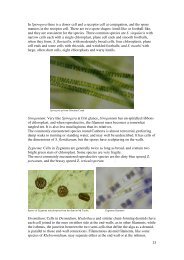Filamentous Freshwater Algae of the ACT, a preliminary list
Filamentous Freshwater Algae of the ACT, a preliminary list
Filamentous Freshwater Algae of the ACT, a preliminary list
Create successful ePaper yourself
Turn your PDF publications into a flip-book with our unique Google optimized e-Paper software.
Oscillatoria sp. aff. limosa from Cooma<br />
Specimens are from <strong>the</strong> Numeralla River, but have probably been overlooked<br />
throughout <strong>the</strong> Murrumbidgee, wherever <strong>the</strong>re is a bit <strong>of</strong> backwater formation.<br />
‘Snots’<br />
In contrast to <strong>the</strong> regular cell form <strong>of</strong> <strong>the</strong> cyanoprokaryotes discussed above, <strong>the</strong> Snots<br />
have at least two and sometimes several cell shapes within each trichome. Each<br />
different cell form indicates specialisation in <strong>the</strong> behaviour <strong>of</strong> that cell while all cells<br />
contribute to <strong>the</strong> vitality <strong>of</strong> <strong>the</strong> whole organism. There are vegetative cells with dense<br />
pigmentation; heterocytes with thick walls, pearly cytoplasm and pit connexions to<br />
<strong>the</strong> next cells, that fix nitrogen; akinetes <strong>of</strong> various shapes, that form wea<strong>the</strong>rpro<strong>of</strong><br />
propagules within one cell wall; hair cells that contain little or no cytoplasm but form<br />
<strong>the</strong> exposed ends <strong>of</strong> trichomes and several o<strong>the</strong>rs. Many snots also have a colonial life<br />
style, from loose sheet-like aggregations, to interconnected sheath-networks or <strong>the</strong><br />
organised arrays <strong>of</strong> individual filaments within a gelatinous matrix. A selection <strong>of</strong><br />
species, not uncommon in <strong>the</strong> eastern states <strong>of</strong> Australia is discussed in Skinner &<br />
Entwisle (2001). Two examples will be discussed here.<br />
Hydrocoryne sp.<br />
The dark green goo that forms on reeds and rushes just at water level very <strong>of</strong>ten has a<br />
very high proportion <strong>of</strong> this organism. The ‘bath-tub ring’ is very important in <strong>the</strong><br />
productivity <strong>of</strong> river systems, particularly in times <strong>of</strong> high turbidity, and while <strong>the</strong>re<br />
are many diatoms and green algae in <strong>the</strong> mixture, where <strong>the</strong> ring has <strong>the</strong> feel and<br />
consistency <strong>of</strong> wet mid-green paint, and that geosmin smell, you are more than likely<br />
looking at Hydrocoryne.<br />
The thallus is a three dimensional array <strong>of</strong> mostly straight moniliform (chains <strong>of</strong><br />
beads) trichomes, most with numerous rounded cylindrical vegetative cells, scattered<br />
heterocytes (nitrogen fixers) and occasional runs <strong>of</strong> thick-walled akinetes. Each<br />
trichome is surrounded by a diffuse gelatinous sheath and so <strong>the</strong> whole thallus may<br />
coat an area <strong>of</strong> its substrate, generally a larger filamentous alga, stonewort or aquatic<br />
plant.<br />
Although <strong>the</strong> collections are from <strong>the</strong> upper Monaro, <strong>the</strong> organism has been noted in<br />
both Lake Tuggeranong and Lake Ginninderra and is probably widespread.<br />
Nostoc commune<br />
This really is Snot, <strong>the</strong> scientific name translates as ‘<strong>the</strong> widespread snot’. The<br />
colonies are usually billowing sheets <strong>of</strong> khaki to dark brown firmly gelatinous<br />
material that does look much like drying mucilage from <strong>the</strong> nose (snot). The sheets<br />
start <strong>of</strong>f in waterlogged flood runners or drainage lines, or any patch <strong>of</strong> broken ground<br />
16



